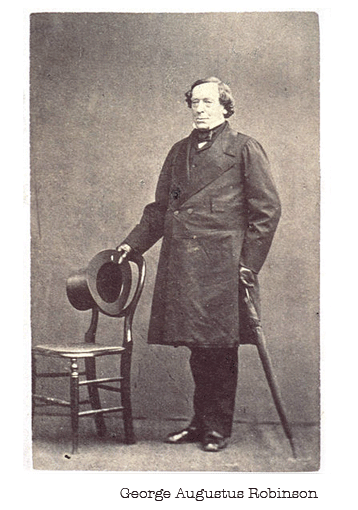The La Trobe Journal
Article: No 86 December 2010
The Pacificator: discovering the lost bust of George Augustus Robinson
The Pacificator: discovering the lost bust of George Augustus Robinson
Author: Gareth Knapman
CLICK HERE TO DOWNLOAD THE DOCUMENT
George Augustus Robinson [The Pacificator]
From Wikipedia, the free encyclopedia .... Click here to go to source and the entry
"George Augustus Robinson (22 March 1791 – 18 October 1866) was a builder and untrained preacher. He was the Chief Protector of Aborigines in Port Phillip District from 1839 to 1849. Prior to his appointment as the Chief Protector of Aborigines by the Colonial Office in Great Britain, he had been called upon to mount a "friendly mission" to find the 300 remaining [A]boriginals in Tasmania."
•••
•••
CLICK ON THE IMAGE TO ENLARGE
"The / Aborigines / of / Tasmania / A Series of Original Etchings and Sketches / of the Natives brought in by the Conciliatory / Mission under G. A. Robinson. / Hobart Town / 1834-35 [Duterrau]" ... Click here to access the album
Notes on Duterrau, Benjamin (1767–1851) by A. Rand
"Benjamin Duterrau (1767-1851), artist, was born in London to parents of French descent and was apprenticed in his youth to an engraver. Between 1817 and 1823 he exhibited six portraits at the Royal Academy and three genre pieces at the British Institution. Duterrau married a Miss Perigal whose family was in partnership with Duterrau's as makers of watches and clocks, New Bond Street, London. In the early 1830s Duterrau and his only daughter, Sarah Jane, arranged to emigrate to Van Diemen's Land as drawing master and as music teacher at Ellinthorp Hall, a school at Ross, conducted by Mrs George Clark. Before their departure, however, Henry Mundy, a teacher of both subjects, was engaged. Nevertheless the Duterraus embarked in the Laing, and arrived in August 1832. Sarah Duterrau became governess to the children of Lieutenant-Governor (Sir) George Arthur and, after marrying John Bogle of the firm of Kerr & Bogle, merchants, in February 1838 went with him to Scotland in 1839; she died at Torquay in 1885." ... Click here to access Rand's notes
"This 1840 painting idealised the work of George Augustus Robinson, who took up the post of 'Protector of Aborigines' in Van Diemen's Land on 27 January 1830. Benjamin Duterrau's The Conciliation was considered the first historical epic painting in the Australian colonies; it now marks the long path towards legal acknowledgment of Tasmanians of Indigenous descent."
CLICK ON THE IMAGE TO ENLARGE
•••
Child of the metropolis: George Augustus Robinson in London
Jacqueline D'Arcy
Jacqueline D'Arcy
Abstract
This paper argues that historians have too readily accepted Vivienne Rae-Ellis’s account of the reasons behind George Robinson’s emigration to Hobart. It debunks the idea that Robinson fled England in disgrace and reveals that Robinson had been considering immigration for a number of years prior to his departure. This paper also establishes that it was Robinson’s links to various social networks in England, especially humanitarian and military networks, that laid the foundations for his easy integration into and success in colonial society. Its detailed picture of Robinson’s early life challenges the current historiography, which in the main has used Rae-Ellis’s inaccurate account as a platform to attack his character and to misconstrue his later career with the Aborigines in both Van Diemen’s Land and Port Phillip.
This paper argues that historians have too readily accepted Vivienne Rae-Ellis’s account of the reasons behind George Robinson’s emigration to Hobart. It debunks the idea that Robinson fled England in disgrace and reveals that Robinson had been considering immigration for a number of years prior to his departure. This paper also establishes that it was Robinson’s links to various social networks in England, especially humanitarian and military networks, that laid the foundations for his easy integration into and success in colonial society. Its detailed picture of Robinson’s early life challenges the current historiography, which in the main has used Rae-Ellis’s inaccurate account as a platform to attack his character and to misconstrue his later career with the Aborigines in both Van Diemen’s Land and Port Phillip.
This article was supported by a 2009 CAL/AHA bursary and has been peer-reviewed.














